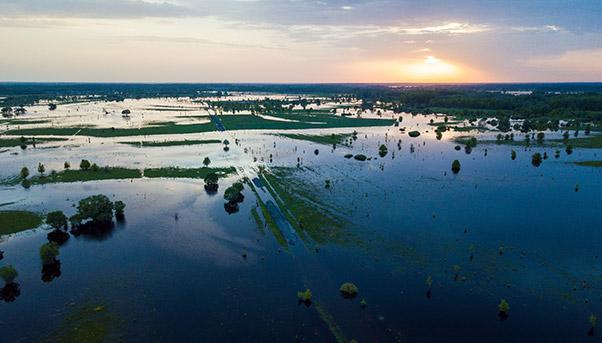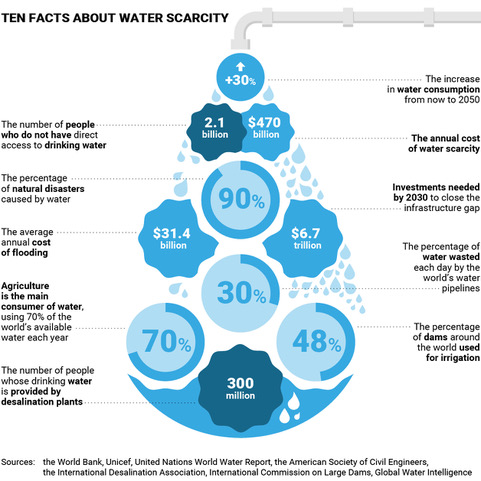
Demand for water is growing but its availability is dwindling. And the cost of the precious resource – without which life would be impossible – is rising as a result. Investments are needed to break this vicious circle. Infrastructure networks must be modernised, while new technologies and processes such as desalination must be adopted. Without these, increasing water scarcity threatens to worsen the quality of life of billions of people. A few days after “World Water Day 2019“, “We Build Value” explores the issue by answering 10 questions with statistics gathered from authoritative international organisations.
How much has global water consumption increased?
Since the 1980s, consumption has risen 1% every year due to a combination of factors ranging from population growth to socio-economic development and changing lifestyles to consumer behaviour. This growth rate is expected to continue until 2050, reaching an increase from today’s levels of close to 30%.
How many people suffer from water scarcity?
More than 2.1 billion people do not have direct access to potable water. Some 80% of them live in rural areas. This situation is destined to get worse as the global population is expected to rise by another two billion by 2050 and the demand for water to increase by 30% from today.
What is the cost of water scarcity and the resulting low levels of hygiene?
According to the “World Water Development Report” published by the United Nations on March 19, if the pressure on available water resources remains unchanged in the coming years, it will lead to a 45% drop in the world’s gross domestic product by 2050, putting 40% of wheat production at risk.
In absolute terms, the estimated total annual collective cost due to water scarcity and low hygiene standards is equal to $470 billion.
What is the role of water in severe weather events?
About 90% of natural disasters are related to water. Between 1995 and 2015, 43% of natural disasters were floods, which affected 2.3 billion people, killing 157,000 and causing economic damage worth $662 billion. In the same period, droughts represented 5% of natural disasters, affecting 1.1 billion people and causing $100 billion in damages.
How much do droughts and floods cost?
In recent years, there has been an intensification of extreme atmospheric phenomena that relate to water. Drought is afflicting ever larger areas. Floods have exposed the inadequacy of urban wastewater management systems. The average annual economic damage caused by drought is calculated at $5.4 billion, while floods cost a combined $31.4 billion.

What sort of investments are needed to bridge the infrastructure gap?
Massive modernisation — from water management networks to irrigation and cultivation systems — is essential to prevent the world from suffering a serious water shortage in the coming years. To bridge the gap, an estimated $6.7 trillion will need to be spent by 2030, and $22.6 trillion by 2050. Investments of up to $1 trillion will be required to maintain and expand the water management network during the next 25 years.
How much water is wasted every year?
Every year, water pipelines around the world lose on average 25% to 30% of the water they manage for a loss of $14 billion.
In the United States, 22 million litres of drinking water are wasted every day, while an average 240,000 water main breaks occur throughout the national network.
Along with a modernisation of the network, another solution to combat water loss is adopting digital control and monitoring systems. The value of this market is expected to increase from $21.3 billion in 2016 to $30.1 billion by 2021.
What is the biggest source of water consumption?
The main source of water consumption is agriculture, which uses 70% of freshwater resources each year. Industry accounts for 20%, while 9% is consumed for domestic purposes and only 1% is for drinking.
What role do dams play?
Dams are one of the most efficient ways to manage water, both for irrigation and energy production. About 48% of dams are used for irrigation; 17% for electricity production; 13% for the supply of water for domestic use; 10% for flood control; 5% for water supply for recreational purposes; and 1% for fishing.
How important is desalination?
Desalination is an industrial process that transforms salt water from seas and oceans into drinking water. Desalination plants are used by 300 million people in 150 countries. Most of the world’s plants are in countries located in the Gulf, where treated water supplies 90% of the amount used for domestic purposes.
Fisia Italimpianti, the company controlled by Salini Impregilo that specialises in the construction of desalination plants, has built some of the most important plants in Saudi Arabia, Dubai, Abu Dhabi, Kuwait and Qatar.
The sources for this article are: the World Bank, UNICEF, the United Nations World Water Report, the American Society of Civil Engineers, the International Desalination Association, International Commission on Large Dams and Global Water Intelligence

